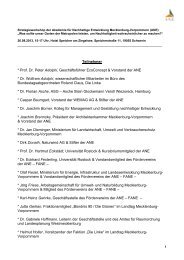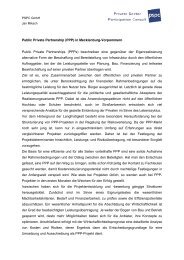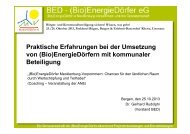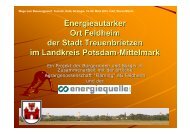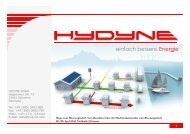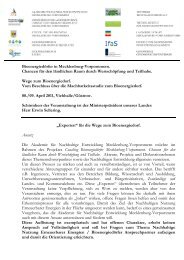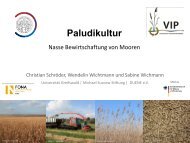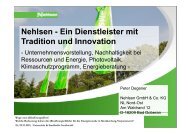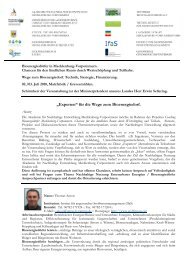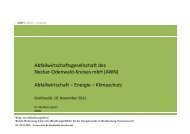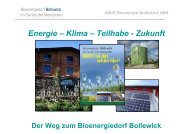Preben Maegaard: Eine Welt im Zeichen der Erneuerbaren Energien ...
Preben Maegaard: Eine Welt im Zeichen der Erneuerbaren Energien ...
Preben Maegaard: Eine Welt im Zeichen der Erneuerbaren Energien ...
Erfolgreiche ePaper selbst erstellen
Machen Sie aus Ihren PDF Publikationen ein blätterbares Flipbook mit unserer einzigartigen Google optimierten e-Paper Software.
Bürger- und Kommunalbeteiligung sichern! Wissen, was geht!<br />
25./26. Oktober 2013, Parkhotel Rügen, Bergen & Erlebnis-Bauernhof Kliewe, Ummanz<br />
<strong>Eine</strong> <strong>Welt</strong> <strong>im</strong> <strong>Zeichen</strong><br />
<strong>der</strong> <strong>Erneuerbaren</strong> <strong>Energien</strong><br />
Biomass<br />
<strong>Preben</strong> <strong>Maegaard</strong>,<br />
Grün<strong>der</strong>, Nordic Folkecenter for Renewable Energy<br />
Senior Vizepresident, EUROSOLAR<br />
Chairman, WCRE, <strong>Welt</strong>rat für Erneuerbare <strong>Energien</strong>,<br />
Vortrag , Strategisches Kooperationsnetzwerk,<br />
Bergen auf Rügen, 25. Oktober 2013
Glie<strong>der</strong>ung<br />
1. Folkecenter für erneuerbare <strong>Energien</strong><br />
2. Die 100% EE-Kommune Thisted<br />
3. Energie Demokratie und Autonomie<br />
4. Wind und Solar fluktuiert!<br />
5. Dänische Energiepolitik seit 1975<br />
6. Das Wind Buch<br />
Folkecenter for Renewable Energy
1.Das Nordic Folkecenter<br />
Folkecenter for Renewable Energy
Seit 1909 Windpower in Ydby,<br />
dem Sitz des Folkecenters<br />
Folkecenter for Renewable Energy
Energie Infrastruktur Dänemark<br />
1985 & 2009
Folkecenter for Renewable Energy
Solar,Wind. Biomass<br />
Folkecenter for Renewable Energy
Biodome
15 Solar Wärme Anlagen<br />
1983 bis heite<br />
Folkecenter for Renewable Energy
Konferences
Solar- Wind- und Erdwärme
Folkecenter for Renewable Energy
2. Die 100% EE- Kommune<br />
Thisted sed<br />
Folkecenter for Renewable Energy
ANTEIL VON WIND KRAFT IN DÄNEMARK:<br />
‣ 2007: 18%<br />
‣ 2010: 25%<br />
‣ 2013: 33%<br />
‣ 2020: 50%<br />
‣ 2030: 65%
Thisted Kommune in Thy –<br />
Elektrizitaet aus erneuerbaren Quellen: 100%<br />
Raumheizung aus erneuerbarer Energie:<br />
86%
Thisted Kommune, Thy<br />
• Thisted Kommune in Thy auf einer Fläche 1.093 km2,<br />
• mit ca. 46,000 Einwohnern<br />
• <strong>Eine</strong> <strong>der</strong> grössten Kommunen Dänemarks<br />
• Laendliche Region ist klein hügelig, Bauernland und zarte<br />
Fördelandschaft<br />
• 100 km einmalige Küstenlinie<br />
• grossartiges Surfen ‘Cold Hawaii’<br />
• Erster National Park in Dänemark<br />
• 2007 erhielt Thy<br />
den Europäischen Solar Preis fuer seinen aussergewöhnlich<br />
de uopäsc e Soa es ue se e ausse ge ö c<br />
hohen Anteil an erneuerbarer Energie
Die Integration von Windkraft<br />
und KWK<br />
Folkecenter for Renewable Energy<br />
Vorteile <strong>der</strong> Integration:<br />
ti<br />
•Windkraft wird vor Ort<br />
genutzt. Keine langen<br />
Übertragungsstrecken<br />
• Neue lokale Einnahmequellen<br />
bedeuten Akzeptanz<br />
<strong>der</strong> neuen <strong>Energien</strong><br />
• Austausch <strong>der</strong> fossielen<br />
Brennstoffe durch Biogas in<br />
KWK’s<br />
• Biomasse als ein günstiges<br />
Energiespeichermedium
Elektrizitaets Verbrauch<br />
• Die jährliche Erzeugung<br />
von 119 Windmühlen<br />
zusammen mit Biogas<br />
und KWK aus Abfall<br />
ergibt 100% des<br />
elektrischen Stroms von<br />
Thisted Kommune
THY – 2,5 KW windpower per capita<br />
kW pr. capita<br />
3<br />
2,5<br />
/capita<br />
kW<br />
2<br />
1,5<br />
1<br />
0,5<br />
0<br />
Thy Denmark Spain Germany USA UK France<br />
Country
Lokales Engagement<br />
Drei wichtige Dinge<br />
zu erinnern bezüglich Thisted:<br />
•Thisted hat seine Bürger aktiv beteiligt<br />
•Thisted hat seine lokalen Firmen beteiligt<br />
•Thisted braucht ausgereifte Technologie die existiert<br />
•Die bringen das beste Ergebnis, wenn sie sensibel und<br />
wirtschaftlich angewendet werden
Stadtwerke in Thy<br />
• Stadtwerke sind Eigentum <strong>der</strong> Verbraucher und werden<br />
von ihnen betrieben<br />
• Stadtwerke nutzen die dezentrale Form <strong>der</strong><br />
ökologischen Energie-Erzeugung<br />
• Windstrom, Biogas, Biomasse und KWK sind Beispiele<br />
für solche Infrastrukturen<br />
• Finanzielle Erfolge kommen den Verbrauchern zugute<br />
• Die Stadt hat die Wahl und wird die beste Infrastruktur<br />
wählen, die am besten ihren Bedarf deckt und am<br />
wirksamsten ist.<br />
Folkecenter for Renewable Energy
• Neue Erfahrungen geben <strong>der</strong> Bevölkerung Inspiration<br />
und Freude. Diese bringt die lokale Acceptanz für<br />
Windkraft voran.
Starke lokale Unterstützung<br />
Starke lokale Unterstützung als Antriebsmotor:<br />
• Lokaler Besitz <strong>der</strong> Windmühlen<br />
• Bau und Besitz von Biogasanlagen durch<br />
ansässige Bauern<br />
• Alle KWK-Anlagen und Fernwärme-Installationen sind<br />
Verbrauchereigentum<br />
• Neue kommunale Energiegründungs g g Pläne für<br />
zukünftige Windmühlen. 80 MW sind in <strong>der</strong> Plannung<br />
Folkecenter for Renewable Energy
Thisted, 10 Mw el ,12.000 Einwohner<br />
Folkecenter for Renewable Energy
Biomasse–Wärme aus Stroh<br />
Folkecenter for Renewable Energy
Geothermische Wärme in Thisted<br />
Folkecenter for Renewable Energy
Biogas<br />
7000 qm Biogas-Anlage und<br />
2400 kW KWK<br />
Auf <strong>der</strong> Nachbarinsel Mors<br />
Folkecenter for Renewable Energy
Kraftwärmewerke<br />
Bedsted<br />
Hanstholm Hurup Thy<br />
Folkecenter for Renewable Energy
Folkecenter for Renewable Energy
Vorupör, 1,8 MW el , 800 Einwohner
Zusammenfassung<br />
1. Wind, lokale Biomasse und Abfall sind die Hauptressourcen<br />
2. Windturbinen produzieren 80-100 % <strong>der</strong> Elektrizität;<br />
Biomasse, Abfall 20 %<br />
3. Neue kommunale Pläne streben eine Erweiterung <strong>der</strong><br />
Windenergie von 265 GWh/Jahr auf 445 GWh/Jahr an<br />
4. Windenergie ist eine preiswerte Ressource;<br />
bis zu € 0,04/kWh für Wärme<br />
5. Fernwärmeleitungen sind Standard in Dörfern und Städten<br />
6. Kraft-Wärme-Kopplungsanlagen in fast je<strong>der</strong> Stadt (total 35 MWel)<br />
7. Heißwasser für Fernwärme; flüssige und feste Biomasse<br />
dienen <strong>der</strong> Energiespeicherung<br />
8. Leistungsregulierung balanciert das <strong>Energien</strong>etz<br />
Folkecenter for Renewable Energy
3. Zeit für Energiedemokratie?<br />
Die notwendige lokale l Akzeptanz<br />
Folkecenter for Renewable Energy
Zeit für Energiedemokratie
200 Protest Gruppen in Dänemark
Die Lösung
The best wind resources we find<br />
in low-income Denmark.
Local ownership and<br />
income generation
Ownership, acceptance,<br />
new economy
Hvide Sande Down-Town
Hvide Sande:<br />
Onshore Cp factor: 0,52
4.Stromverbrauch ist ”konstant”<br />
Wind und Sonne<br />
flukturieren<br />
Jonglage mit Energie<br />
Folkecenter for Renewable Energy
8 Wochen Windenergie<br />
in Januar/Februar 2007<br />
• Theoretisch werden 2007 temporär 100% des Verbrauches gedeckt<br />
• Mit zusätzlichen 3000 MW würden häufig mehr als 100% des Bedarfs<br />
an Elektrizität erreicht -> Nutzung für Wärmeproduktion<br />
Folkecenter for Renewable Energy
Das Problem existiert schon:<br />
‣WKA werden (wurden) in Perioden mit viel Wind<br />
gestoppt. Gleichzeitig bleiben BHKW auf Erdgas und<br />
Kohle in Betrieb wegen des Bedarfs an Fernwärme<br />
‣Windstrom wird exportiert zu Null- o<strong>der</strong> Minus<br />
Preisen<br />
‣Transmissionsleitungen zum Ausland sind extrem<br />
teuer und eine kurzfristige Lösung<br />
‣Stromspeicherlösungeni h existieren kaum und sind<br />
extrem teuer. Biomasse und warmes Wasser dagegen<br />
können billig und in grossen Mengen gespeichert<br />
werden
Regulierung <strong>der</strong> Stromerzeugung<br />
Import<br />
Erzeugung kann<br />
geregelt werden<br />
Erzeugung kann nicht<br />
geregelt werden<br />
Elektrizitäts<br />
system<br />
Export<br />
Verbrauch<br />
Folkecenter for Renewable Energy
Die Lösung existiert schon:<br />
‣Als Wärme verwendet hat ”excessive” Windstrom den<br />
Wert des Brennstoffes, <strong>der</strong> ersetzt wird.<br />
‣Mit Wind-Kraft-&-Wärme und Sonnenenergie als<br />
Basisversorgung und Biomasse als back-up hat man<br />
eine kostengünstige und realistische Alternative.<br />
‣Nur die Überschüsse, nicht <strong>der</strong> gesamte Windstrom<br />
von 8 TWh (in 2020 18TWh), werden in <strong>der</strong> Zukunft in<br />
105 TWh grossen Fernwärmesektor verwendet und<br />
gespeichert.
Speicher Möglichkeiten<br />
Speicher Möglichkeiten<br />
Kosten und Wirkungsgrad
Power Balancing
Ohne Strom Kessel -<br />
und mit!
Grundlegende Regulierungstechnologie<br />
Lagerung für 2 Tage<br />
Wärme-Bedarf<br />
Grindsted<br />
Boiler<br />
20 MW Elektrischer<br />
Boiler<br />
Folkecenter for Renewable Energy
Stromregulierungs-<br />
technologie<br />
Leistung hoch regulieren<br />
Leistung runter regulieren<br />
Kratholm<br />
Gesamtinvestition niedrig ( weniger als 200€/Kw).<br />
Nur ein Drittel eines konventionellen Kraftwerks !!<br />
Folkecenter for Renewable Energy<br />
Grindsted
Wind Power for Heating in Hanstholm
6 MW Strom Kessel in Snedsted
Strom - Kessel
5. DÄNISCHE ENERGIEPOLITIK<br />
SEIT 1975
Geschichte <strong>der</strong> dänischen Gesetzgebung<br />
in <strong>der</strong> Energiepolitik (1)<br />
Energieversorgungsgesetz 1976:<br />
Alle neu installierten Stromkapazitäten basieren seither 1980 auf <strong>der</strong><br />
Kopplung von Kraft und Wärme (KWK)<br />
• Professor Klaus Illum, Aalborg Universität :<br />
• “Verbrennung für Wärme von Erdgas und Öel ist<br />
thermodynamische Kr<strong>im</strong>inalität!”<br />
for Renewable Energy
Geschichte <strong>der</strong> dänischen Gesetzgebung<br />
in <strong>der</strong> Energiepolitik (2)<br />
Fernwärmegesetz in 1979<br />
‣Einführung <strong>der</strong> Fernwärmeplanung in<br />
lokalen Regierungsebenen<br />
‣Zonenbildung in Fernwärme- und Gasnetzwerken<br />
‣For<strong>der</strong>ung von mehr KWK’s und<br />
erneuerbaren <strong>Energien</strong> für Fernwärme
Rahmenbedingungen für die<br />
Energiepolitik (3)<br />
• Nationale Regierungsämter bauen Rahmenbedingungen in<br />
Kooperation auf<br />
• Lokale Regierungen sind verantwortlich für die Regulierung <strong>der</strong><br />
Infrastruktur<br />
• Verbrauchergesellschaften geben den Impuls zur Anbindung an<br />
Fernwärmenetze o<strong>der</strong> zur Einführung neuer lokaler<br />
Genossenschaften<br />
• Die Gesetzgebung unterstützt einen konkurrenzbetonten Markt für<br />
Equipment und Service<br />
Folkecenter for Renewable Energy
Fernwärme und KWK als wichtigste Verbesserung <strong>der</strong><br />
energetischen Effizienz<br />
60% 10%<br />
100%<br />
40%<br />
100%<br />
40%<br />
Vorher<br />
Jetzt<br />
50%<br />
Folkecenter for Renewable Energy
Über 75% <strong>der</strong> Raumheizung aus Fernwärme<br />
60.000 km Rohrleitungen für Wärme und Kühlung in<br />
ganz Dänemark<br />
Folkecenter for Renewable Energy
Vielfalt von Versorgungsquellen<br />
Folkecenter for Renewable Energy
Entwicklung <strong>der</strong> Fernwärme<br />
Folkecenter for Renewable Energy
KWK, Deutschland<br />
versus Dänemark<br />
Deutsche Energie Agentur:<br />
„Wegen <strong>der</strong> Leitungsverluste und <strong>der</strong> erheblichen<br />
Kosten bei <strong>der</strong> Verteilung ist die Fernwärme nur in<br />
Ballungsgebieten mit relativ kurzen Verbindungen eine<br />
sinnvolle und effiziente Form <strong>der</strong> Wärmeversorgung.<br />
Der Anteil <strong>der</strong> Wohnungen in Deutschland, die mit<br />
Fernwärme beheizt werden, liegt bei etwa 14<br />
Prozent.“<br />
Source: Deutsche Energie Agentur
Die Zukunft liegt in <strong>der</strong> dezentralen &<br />
autonomen Energieversorgung<br />
Windenergie, Solarenergie und Kraft-Wärme-Kopplung<br />
Folkecenter for Renewable Energy
Stadtwerke in Dänemark<br />
• Stadtwerke sind Eigentum <strong>der</strong> Verbraucher und werden<br />
von ihnen betrieben<br />
• Stadtwerke nutzen die dezentrale Form <strong>der</strong><br />
ökologischen Energie-Erzeugung<br />
• Windstrom, Biogas, Biomasse und KWK sind Beispiele<br />
für solche Infrastrukturen<br />
• Finanzielle Erfolge kommen den Verbrauchern zugute<br />
• Die Stadt hat die Wahl und wird die beste Infrastruktur<br />
wählen, die am besten ihren Bedarf deckt und am<br />
wirksamsten ist.<br />
Folkecenter for Renewable Energy
Vorteile <strong>der</strong> Stadtwerke<br />
• Lokale Stadtwerke besitzen, installieren und betreiben<br />
dezentrale ökologische Stromerzeugungs-Anlagen<br />
g g<br />
• Lokale Umweltverschmutzung wird reduziert, CO2<br />
reduziert, Arbeitsplätze geschaffen, wirtschaftliche<br />
Diversifikation und Entwicklung, Arbeitskräfte werden<br />
fortgebildet.<br />
• Wenn eine Stadt erst Erfahrung hat, kann sie diese<br />
an<strong>der</strong>en Städten und Dörfern weitergeben.<br />
Folkecenter for Renewable Energy
CHP for Large and Small Cities<br />
3.500 kW 350 kW
Holstebro & Struer,<br />
28 Mw el , 44.000 Consumers
Faaborg, 7 Mw el , 7.000 Inhabitants
CHP in Selected Countries
WICHTIGSTE ENERGIERESSOURCE IN 2020:<br />
WIND
Windenergie in Dänemark<br />
Folkecenter for Renewable Energy
Die Regierung 50% Wind Kraft 2020
Denmark, wind power capacity by 2020<br />
Kilde: Min. of Energy, press release<br />
Wind power in Denmark<br />
by 2020<br />
Type of wind power Year/period Installed capacity, MW kWh/€-cents<br />
Existing, End of 2011 3.900 5 - 9<br />
Offshore, Anholt 2013 400 14, 50.000 full load hours<br />
Onshore 2012-2020 1.800 7½, 22.000 full load hours<br />
Near shore (up to 3 km) 2013-2020 500 10½ to be decided<br />
Offshore 2017-2020 1.000 12-15, 50.000 full load hours<br />
Community owned 2012-2020 ------ 5 – 8<br />
Total<br />
6.600 MW (minus repowering)<br />
Source: Min. of Energy, press release
Strom OffshoreKabel
Nord See Offshore Kabel,<br />
existierende and geplante
• ” In Skandinavien steht<br />
schon heute ein<br />
Speichervolumen in<br />
Stauseen zur Verfügung,<br />
das einen Großteil des<br />
kurzfristigen europäischen<br />
Speicherenergiebedarfs<br />
decken könnte. Allerdings<br />
fehlt in <strong>der</strong> Regel das<br />
Unterbecken und für den<br />
Transport <strong>der</strong> Energie<br />
bräuchte es gigantische<br />
gg<br />
Netze.”<br />
•
Elektrizitätspreise in Europa;<br />
exkl. VAT und Steuern<br />
DKK per kWh<br />
09 0,9<br />
0,8<br />
0,7<br />
0,6<br />
0,5<br />
0,4<br />
0,3<br />
0,2<br />
0,1<br />
0,0<br />
IE IT LU UK DE NL BE PT EU15 AT ES GR DK SE NO FR FI<br />
15 Source: Eurostat<br />
2006 2007<br />
Folkecenter for Renewable Energy
6. DAS WIND BUCH
• New Book
MODERN WIND TURBINE
Most wind energy history writing<br />
relates to the <strong>im</strong>portant<br />
industrialisation that emerges in<br />
the early 1980s; but how the<br />
product, the mo<strong>der</strong>n 3-bladed wind<br />
turbine came into being, who, how<br />
and what in the proceeding period<br />
caused the success are fragments of<br />
a broad and often subtle process.<br />
We endeavour to put more light on<br />
that period in the first part of the<br />
book entitled “The Rise of Mo<strong>der</strong>n<br />
Wind Energy”.
Wind power has been used since centuries. The first windmills ill were in use<br />
in Iran at least by the 9th century and possibly as early as the 7th century.<br />
The use of windmills became widespread across the Middle East and Central<br />
Asia, and later spread to China and India. Windmills were used extensively<br />
in Northwestern Europe to grind flour from the 1180s, and wind pumps were<br />
used to drain land for agriculture and for building.<br />
Wind energy - mechanical power
July 1887: the Scottish<br />
academic, Professor James<br />
Blyth, built a cloth-sailed<br />
wind turbine in the garden<br />
of his holiday cottage in<br />
Marykirk and used the<br />
electricity it produced to<br />
charge accumulators for<br />
the lights in his cottage.<br />
Winter 1887/88: the US<br />
inventor Charles F. Brush<br />
produced electricity<br />
using a wind powered<br />
generator which powered<br />
his home and laboratory<br />
until about 1900.<br />
Wind energy - electrical power<br />
1890s: the Danish<br />
scientist and inventor<br />
Poul la Cour constructed<br />
wind turbines to generate<br />
electricity, to produce<br />
hydrogen and oxygen by<br />
electrolysis and was<br />
stored for use as a fuel.
La Cour was the first to discover that fast rotating wind turbines with<br />
fewer rotor blades were the most efficient in generating electricity.<br />
Poul la Cour (1846 -1908)
Johannes Juul (1887 -1969)
Towards the DANISH CONCEPT<br />
In 1957 J. Juul erected a 200 kW wind turbine<br />
in Gedser. It was an up-scaled version of the<br />
3-bladed Bogø wind turbine, but with a more<br />
advanced system of self-regulation.<br />
Features:<br />
3 blades, stall-regulated, tip brakes, integrated<br />
gearbox, asynchronous generator, chain drive<br />
transmission, 25 m concrete tower.<br />
The only large-scale mo<strong>der</strong>n wind turbine<br />
in the world that had worked steadily for<br />
10 years and was a major technological<br />
breakthrough of mo<strong>der</strong>n wind power.<br />
FLS Gedser wind turbine
The 2 MW Tvind<br />
windmill, designed<br />
and built by a<br />
group of amateurs<br />
and idealists from<br />
the Tvind School.<br />
TVIND Wind Turbine (1975-78)
Ulrich W. Hütter (1910 - 1990)
The newly founded Økær Vind<br />
Energi brought to the market<br />
Tvind’s downscaled 4.5 m<br />
fibreglass blade, the basis of the<br />
emerging component wind<br />
turbine.<br />
Hütter / TVIND / Økær Vind Energi
Folkecenter for Renewable Energy<br />
Two generations of<br />
gearboxes. To the left, FLStype<br />
integrated gearbox from<br />
1942 as used on the Bogø and<br />
the first Gedser windmill. The<br />
white gear to the right came<br />
from Tacke Getriebe in 1992.<br />
It is installed in Hanstholm,<br />
on the 525 kW windmill<br />
designed by Folkecenter and<br />
s<strong>im</strong>ilar Tacke wind turbines.<br />
Bendy Poulsen and <strong>Preben</strong> <strong>Maegaard</strong><br />
with the prototype 22 kW made 1978<br />
at H. Poulsen & Søn’s workshop in<br />
Lyngs, using the technical counselling<br />
of NIVE.
MODERN WIND TURBINE<br />
• Heavy<br />
• upwind<br />
• 3-bladed<br />
• asynchronous generator<br />
• stall-regulated<br />
+<br />
Huetter/Tvind blade design<br />
/ root system
The development of mo<strong>der</strong>n wind turbine
„From Herborg Blacksmith to Vestas“<br />
by Henrik Stiesdal
CALIFORNIA, USA<br />
Californian Wind Rush<br />
During the 1980s, wind<br />
industry in the USA, the<br />
biggest economy of the<br />
world, passed through a<br />
rapid rise and fall with<br />
later ups and downs.
GERMANY<br />
The German progressive legislation (Renewable<br />
Energy Law) and innovative Feed-in Tariffs<br />
demonstrated that political visions and will, can<br />
make Europe’s largest economy the champion of<br />
wind energy.<br />
<strong>Preben</strong> <strong>Maegaard</strong> & Hermann Scheer
Rapid growth of wind power in China…<br />
CHINA<br />
In 2005, China in search for additional electricity<br />
production capacity and with an eye for a new<br />
industrial growth sector also joined the wind energy<br />
frontrunners. By opening the door for the best<br />
available technology the biggest nation in the world<br />
intentionally avoided mistakes that delayed the<br />
industrialisation in most other countries. Soon China<br />
got its own complete supply chain and more than fifty<br />
MW-size suppliers of wind turbines. During a five years<br />
period and a concerted effort a completely new<br />
industry emerged that made China the absolute lea<strong>der</strong><br />
both in terms of manufacturing and installed wind<br />
power capacity.<br />
A t f th i t l g l i l d d i Chi ‘ 12th Fi Y Pl (2011 2015)<br />
As part of the environmental goals included in China‘s 12th Five Year Plan (2011-2015)<br />
targets have been set for non-fossil energy to account for 11.4% of the total energy<br />
consumption, and for CO 2 discharge per unit of GDP to reduce by 17%.
… triggered by WWEA<br />
CHINA<br />
World Wind Energy Conference & Exhibition (WWEC), Beijing, China, 2004
www.wwindea.org<br />
World Wind Energy Conference (WWEC13), June 2013, Havana, Cuba.
WIND POWER for the WORLD<br />
> Editors<br />
<strong>Preben</strong> <strong>Maegaard</strong> is foun<strong>der</strong> and director<br />
Anna Krenz is an editor, artist, architect and<br />
Wolfgang Palz is chairperson of the World<br />
emeritus of the Nordic Folkecenter for<br />
Renewable Energy, Denmark, chairperson<br />
of the World Council for Renewable<br />
Energy, Germany, senior vice president of<br />
freelance journalist. Since 2001, she has<br />
been associated with the Nordic Folkecenter<br />
for Renewable Energy, Denmark, as a<br />
freelance creative member. Anna is<br />
Council for Renewable Energy, Germany.<br />
Palz has authored the book Solar<br />
Electricity, which was published by<br />
UNESCO. He has also edited the book<br />
EUROSOLAR, Germany, and co-foun<strong>der</strong><br />
and president emeritus of World Wind<br />
Energy Association, Germany. He is a<br />
Danish renewable energy pioneer, author<br />
and expert. www.maegaard.net<br />
co-foun<strong>der</strong> of Gallery ZERO, Berlin, and<br />
music band The Curators. Currently, her<br />
work focuses on social, political and<br />
environmental issues, especially wind power.<br />
www.annakrenz.net<br />
“Power for the World: The Emergence of<br />
Electricity from the Sun”. Palz is a bearer of<br />
an Or<strong>der</strong> of Merit of Germany, has been<br />
recognised as a wind energy pioneer in<br />
Britain and has received the European<br />
prizes for biomass, wind energy and solar<br />
photovoltaics.
ASIA: China „Wind Energy Development<br />
in China“<br />
by He Dexin<br />
„Non-Grid-Connected Wind Power and Offshore<br />
“Three Gorges of Wind Power” in China“<br />
by Gu Weidong
Thank you
Biographical References<br />
1. <strong>Maegaard</strong>, P., Palz, W., Krenz, A.: "Power for the World. The Rise of<br />
Wind Energy”, Vol. 2– 3, Pan Stanford, Singapore, 2013<br />
2. <strong>Maegaard</strong>, P.: "Integrated Systems to Reduce Global Warming" in<br />
"Handbook of Cl<strong>im</strong>ate Mitigation", Springer Science, New York, 2012<br />
3. El Bassam, N., <strong>Maegaard</strong>, P., Schlichting, M.L., "Distributed<br />
Renewable Energies for Off-Grid Communities," Elsevier Science,<br />
New York, 2012.<br />
4. <strong>Maegaard</strong>, P., "Wind Energy Development and Application Prospects,<br />
of Non-Grid-Connected Wind Power," in: Proceedings of 2009 World<br />
Non-Grid-Connected Wind, 2010 Conference. IEEE Press.
End of the Presentation<br />
Vielen Dank fuer die Aufmerksamkeit!<br />
Fuer weitere Informationen<br />
Bitte besuchen Sie uns!<br />
www.folkecenter.net<br />
www.eurosolar.org<br />
org<br />
Email: pm@folkecenter.dk
Bespiel Dänemark in Greifswald 2009:<br />
Dezentrale Kraftwärme,<br />
1 Kwel pro Einwohner, dazu 1,4 KWth Wärmeleistung<br />
Wolgast, Gr<strong>im</strong>men, Lubmin,<br />
Anklam,Heringsdorf, Friedland, Stralsund,<br />
Uekermünde, Pasewalk, Demmin,<br />
Greifswald, Teterow, Bergen, Rostock<br />
450.000 Einwohner – 450 MWel und 600 MW<br />
Wärme



